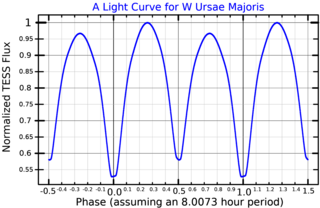
W Ursae Majoris is the variable star designation for a binary star system in the northern constellation of Ursa Major. It has an apparent visual magnitude of about 7.9, which is too faint to be seen with the naked eye. However, it can be viewed with a small telescope. Parallax measurements place it at a distance of roughly 169 light years (52 parsecs) from Earth.
Kappa Ursae Majoris is a binary star in the constellation of Ursa Major. With a combined apparent magnitude of +3.60, the system is approximately 358 light-years from Earth.
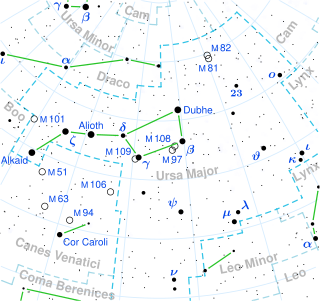
Omega Ursae Majoris is the Bayer designation for a binary star system in the northern circumpolar constellation of Ursa Major. It is visible to the naked eye with an apparent visual magnitude of 4.61. Based upon an annual parallax shift of 13.24 mas, it is roughly 246 light years from the Sun. At that distance, the visual magnitude of the star is diminished by an extinction factor of 0.11 due to interstellar dust.

S Antliae is a W Ursae Majoris-type eclipsing binary star in Antlia.

Y Sextantis, abbreviated as Y Sex, is a variable star system in the equatorial constellation of Sextans. The system is invisible to the naked eye with a mean apparent visual magnitude of 9.88. It is located roughly at 1,300 light years from the Sun based on parallax.

65 Ursae Majoris, abbreviated as 65 UMa, is a star system in the constellation of Ursa Major. With a combined apparent magnitude of about 6.5, it is at the limit of human eyesight and is just barely visible to the naked eye in ideal conditions. It is about 760 light years away from Earth.
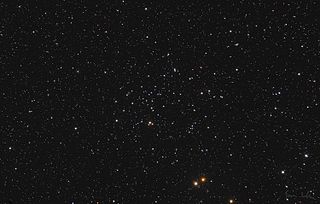
QX Andromedae is an eclipsing binary in the constellation Andromeda. It varies from a maximum apparent visual magnitude of 11.28 to a minimum of 11.50. Since it is impossible to specify the onset time of the eclipses, it is classified as a W Ursae Majoris variable star. It is also observed as an X-ray source and is a member of the open cluster NGC 752.
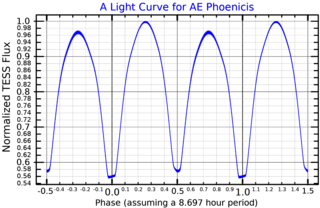
AE Phoenicis is a variable star in the constellation of Phoenix. An eclipsing binary, its apparent magnitude has a maximum of 7.56, dimming to 8.25 during primary eclipse and 8.19 during secondary eclipse. From parallax measurements by the Gaia spacecraft, the system is located at a distance of 168 light-years from Earth.

V752 Centauri is multiple star system and variable star in the constellation of Centaurus. An eclipsing binary, its apparent magnitude has a maximum of 9.10, dimming to 9.66 during primary eclipse and 9.61 during secondary eclipse. Its variability was discovered by Howard Bond in 1970. From parallax measurements by the Gaia spacecraft, the system is located at a distance of 410 light-years from Earth.
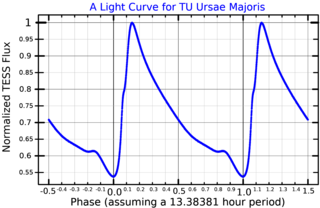
TU Ursae Majoris is a variable star in the northern circumpolar constellation of Ursa Major. It is classified as a Bailey-type 'ab' RR Lyrae variable with a period of 0.557648 days that ranges in brightness from apparent visual magnitude of 9.26 down to 10.24. The distance to this star is approximately 2,090 light years based on parallax measurements. It is located near the north galactic pole at a distance that indicates this is a member of the galactic halo.

TX Ursae Majoris is an eclipsing binary star system in the northern circumpolar constellation of Ursa Major. With a combined apparent visual magnitude of 6.97, the system is too faint to be readily viewed with the naked eye. The pair orbit each other with a period of 3.063 days in a circular orbit, with their orbital plane aligned close to the line of sight from the Earth. During the primary eclipse, the net brightness decreases by 1.74 magnitudes, while the secondary eclipse results in a drop of just 0.07 magnitude. TX UMa is located at a distance of approximately 780 light years from the Sun based on parallax measurements, but is drifting closer with a mean radial velocity of −13 km/s.

UX Ursae Majoris is an Algol type binary star system in the northern circumpolar constellation of Ursa Major. It is classified as a nova-like variable star similar to DQ Herculis, although no eruptions have been reported. Since its discovery in 1933, this system has been the subject of numerous studies attempting to determine its properties. The combined apparent visual magnitude of UX UMa ranges from 12.57 down to 14.15. The system is located at a distance of approximately 952 light years from the Sun based on parallax, and is drifting further away with a radial velocity of 112 km/s.

XY Ursae Majoris is a short period binary star system in the northern circumpolar constellation of Ursa Major. It is an eclipsing binary with a baseline apparent visual magnitude of 9.50. The system is located at a distance of 221.5 light years from the Sun based on parallax measurements, but is drifting closer with a radial velocity of −10 km/s. It has a relatively high proper motion, traversing the celestial sphere at the angular rate of 0.191″·yr−1.

AG Virginis is an eclipsing binary star system in the equatorial constellation of Virgo. With a maximum apparent visual magnitude of 8.51 it is too faint to be visible to the naked eye. The system is located at a distance of approximately 820 light years from the Sun based on parallax measurements.

AH Virginis is a contact binary star system in the equatorial constellation of Virgo, abbreviated AH Vir. It is a variable star with a brightness that peaks at an apparent visual magnitude of 9.18, making it too faint to be viewed with the naked eye. The distance to this system is approximately 338 light years based on parallax measurements, and it is drifting further away with a mean radial velocity of 7 km/s. O. J. Eggen in 1969 included this system as a probable member of the Wolf 630 group of co-moving stars.

SW Ursae Majoris is a cataclysmic binary star system in the northern circumpolar constellation of Ursa Major, abbreviated SW UMa. During quiescence it has an apparent visual magnitude of 16.5–17, which is too faint to be visible to the naked eye. Based on parallax measurements, it is located at a distance of approximately 526 light years from the Sun.

VV Ursae Majoris is a binary star system in the northern circumpolar constellation of Ursa Major, abbreviated VV UMa. It is a variable star system with a brightness that cycles around an apparent visual magnitude of 10.19, making it too faint to be visible to the naked eye. The system is located at a distance of approximately 1,500 light years based on parallax measurements.

AW Ursae Majoris is a binary star system in the northern circumpolar constellation of Ursa Major, abbreviated AW UMa. It is an A-type W Ursae Majoris variable with an apparent visual magnitude of 6.83, which is near the lower limit of visibility to the naked eye. This is an eclipsing binary with the brightness dropping to magnitude 7.13 during the primary eclipse and to 7.08 with the secondary eclipse. Parallax measurements give a distance estimate of 221 light years from the Sun. It is drifting closer to the Sun with a radial velocity of approximately −17 km/s. The system has a high proper motion, traversing the celestial sphere at the rate of 0.216 arc second per annum.
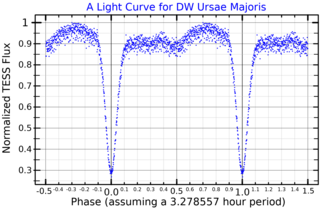
DW Ursae Majoris is an eclipsing binary star system in the northern circumpolar constellation of Ursa Major, abbreviated DW UMa. It is a cataclysmic variable of the SX Sextanis type, consisting of a compact white dwarf that is accreting matter from an orbiting companion star. The brightness of this source ranges from an apparent visual magnitude of 13.6 down to magnitude 18, which is too faint to be viewed with the naked eye. The distance to this system is approximately 1,920 light years based on parallax measurements.

2 Ursae Majoris is an Am star in the northern circumpolar constellation of Ursa Major, located 150 light-years from the Sun. It has the Bayer designation A Ursae Majoris; 2 Ursae Majoris is the Flamsteed designation. It is visible to the naked eye as a faint white star with an apparent visual magnitude of 5.5. Currently 150 light years away, it is moving closer to the Earth with a heliocentric radial velocity of −17 km/s.

















